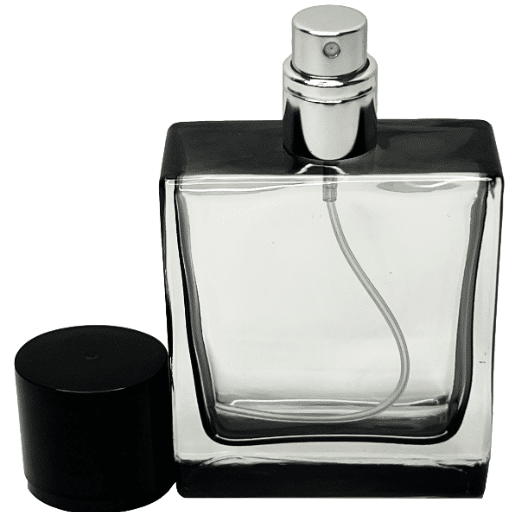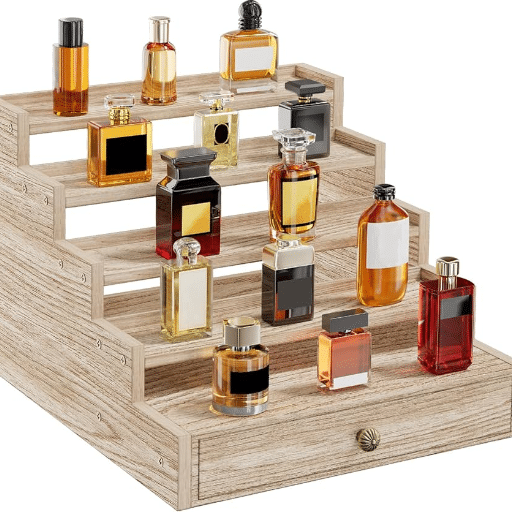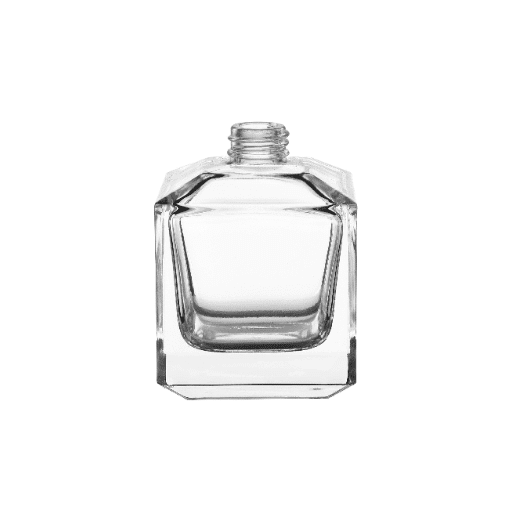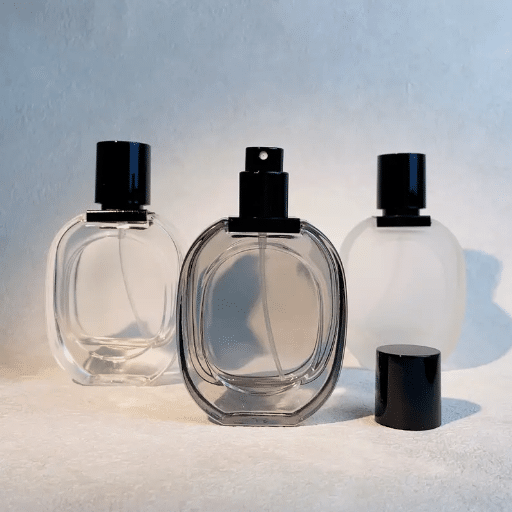Although transferring perfume may appear to be difficult, using the correct instruments and techniques makes it clean and straightforward. This can be whether you want to downsize the fragrance into a smaller carrying case to aid travel, deplete the last remnants of the precious scent, or give a friend the most delightful scent of all. To achieve this, it is essential to understand the correct method for transferring the perfume, as it involves maintaining its quality. Detailed information and practical recommendations are provided in this how-to guide, which offers a step-by-step description of transferring perfume. Following these instructions should help you transfer perfume successfully. Learn how to care for your perfumes properly.
Understanding the Need to Transfer Perfume
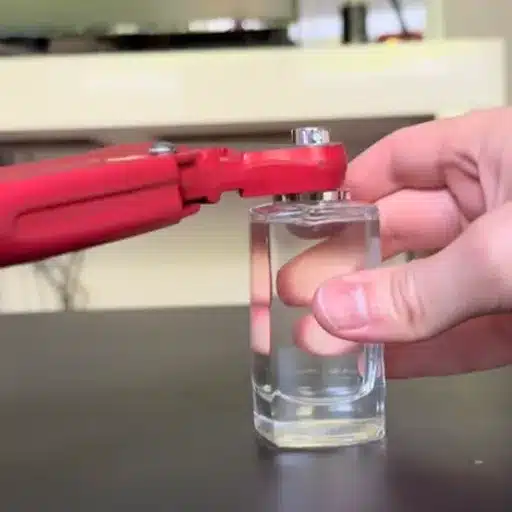
As an alternative, if the perfume cannot be carried in its original bottle, it can be transferred and easily transported in small bottles. Additionally, this also contributes to the longevity of the original bottle, as the frequency of opening and exposure to air is decreased. Transferring perfume also fits well when a backup of a desired fragrance is needed to be decanted so that there would be no work with carrying old perfume vessels with them. When performed with ingredients and methods as required, loss of fragrance and lasting power of the perfume is none.
Reasons for Transferring Perfume
- Traveling Just Got Less Stressful: Smaller bottles are easier to carry and are compatible with the liquid carry-on requirements of many airlines, while also being less prone to causing damage or spills of their contents during travel.
- Protection of the Scent: With the help of a decanter, one prevents the frequent opening of the original bottle’s entrance, which exposes the fragrances to light and air that easily modify the structure and aroma of the perfume, potentially causing a loss of quality.
- Extending: Decantation helps enthusiasts enjoy their chosen perfumes without resorting to using the entire bottle on a friend or family member.
- Non-burdensome option: Things vacated for insensible sprays of perfume are traded for a lightweight bottled perfume for everyday carrying.
- Trying Before Buying: Transferring small amounts of fragrance can be helpful for individual testing, where the fragrance can be applied to the skin or smelled to evaluate it fully without purchasing the entire bottle.
Benefits of Using a Spray Bottle
Even Distribution
Use of a spray bottle creates a consistent mist which helps to spread the perfume evenly in the desired areas.
Controlled Usage
This spray function targets specific regions without any excessive liquid build up thereby minimizing wastage in the process.
Hygienic Application
Using a spray bottle circumvents any physical interaction with the perfume thereby minimizing the chances of pollution.
Enhanced Longevity
The act of spraying perfume and its atomization assists in protecting the scent as the air exposure and evaporation are reduced.
Convenience and Portability
The spray bottles are not cumbersome and very easy to use for people who go out often.
⚠️ Common Mistakes to Avoid During Transfer
- Using Non-Compatible Containers: Transferring perfume into containers made of materials unsuitable for use with alcohol or intense fragrances, such as some plastics, can cause chemical reactions or degradation of the materials, thereby altering the scent or quality of the perfume.
- Overfilling the Spray Bottle: Filling the container to the brim eliminates air pressure buildup, which is essential for achieving proper atomization. Hence, it may leak or not work.
- Spillage During Transfer: The lack of use of precise tools, such as a funnel or pipette, can cause spillage, waste perfume, and create a mess.
- Exposure to Air and Light: Exposure to air and light for an extended period during the transfer process can cause the deterioration of fragrance molecules, resulting in a loss of scent quality and longevity.
- Not Cleaning the Container Properly: Additionally, some individuals fail to perform a thorough cleaning and drying procedure on the spray bottle before reuse. The presence of residues or odors could contaminate the perfume, thereby interfering with the original product’s aroma.
Choosing the Right Bottle for Transfer
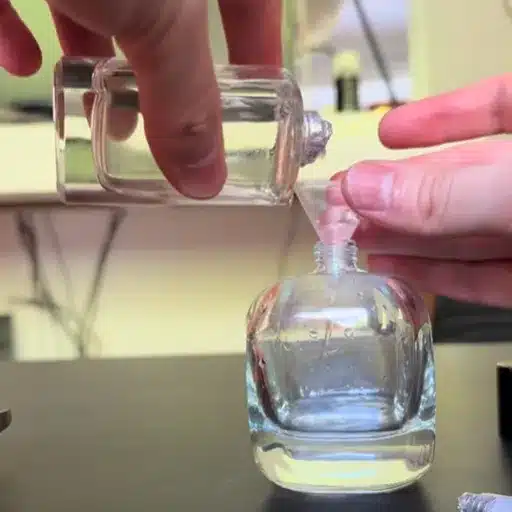
When purchasing bottles for perfume transfer, consider glass or similar high-quality plastic materials suitable for containing scent as the best options. Ensure that the bottle’s mechanism, whether a spray or screw, closes tightly to prevent leakage and contact with air. Choose darker or colored bottles to minimize light exposure to the perfume. Moreover, choose a proper box that minimizes extra space, as it also helps keep the fragrance intact. Lastly, always ensure that the bottle is thoroughly rinsed, cleaned, and completely dry, with no residue remaining.
Types of Bottles Suitable for Perfume
| Type | Material | Features | Lightproof | Leakproof | Ideal Use |
|---|---|---|---|---|---|
| Glass | Glass | Non-reactive, durable | Yes | Yes | Long-term storage |
| Plastic | High-grade plastic | Lightweight, portable | Optional | Yes | Travel |
| Metal | Aluminum | Sturdy, reflective | Yes | Yes | Light-sensitive scents |
| Roller | Glass/plastic | Direct application | Optional | Yes | Precise application |
Why Glass Bottles are Preferred
According to popular belief, glass bottles are best suited for perfume storage because of the non-reactive and impervious nature of glass. In contradistinction to plastic, glass does not chemically react with the delicate compounds in a perfume, instead maintaining the scent’s integrity and longevity. Additionally, glass serves as a more effective protective shield against environmental factors, including moisture, oxygen, and UV light, which can degrade the perfume over time. This is why it is better, as they are suitable for maintenance and preservation over long periods of time.
The container is sustainable from a technical standpoint, as it is eco-label-friendly, being fully recyclable and reusable. Lightweight and clear, the premium appeal of glass works best to elevate the status of high-end perfumes. For those fits of fugacity, light-sensitive fragrances, the glass may come tinted or opaque for further protection —a union of utility and style. Considering performance, durability, and aesthetics, the glass bottle has probably become the industry standard for storing perfumes, largely due to these three factors.
Size Considerations for Travel or Home Use
- Portability: Petite bottle sizes, such as 10ml and 15ml, are ideal for travel, as they weigh less and can be easily tucked into carry-on luggage or smaller bags.
- Regulatory: For air travel, double-check that the bottle size complies with the TSA restriction for liquids, which generally limits containers to 100ml or less.
- Storage: Small bottles occupy less space, conducive to clutter-free storage setups both at home and during travel.
- Quantity of Use: Consider the usage pattern and amount of use; larger bottles are more suitable for home use, whereas smaller ones suffice for occasional use or travel.
- Durability: The very bottle for travel or portability is usually made of materials that ensure that it doesn’t easily spill or break while in transit.
Step-by-Step Guide to Transfer Perfume
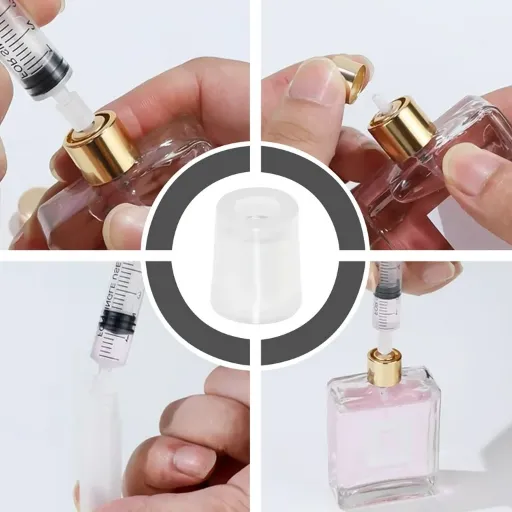
- Prepare Necessary Tools – Assemble the original bottle of perfume, a funnel (ideally made of metal or plastic so as not to cause any reactions), and the travel or empty bottle you wish to fill. All materials should be clean and dry, lest they alter the fragrance.
- Ensure a Clean Workspace – Work on a flat, stable surface, well-lit to avoid accidents. Place some cloth or a paper towel beneath in case anything drips.
- Use a Funnel or a Pipette – If the spray header of the original bottle is removable, remove it very carefully. Place a funnel in the travel bottle so that it may serve as a guide for the liquid. Otherwise, use a pipette to transfer the perfume with slower control.
- Transfer the Perfume – Slowly pour or draw the perfume from the original bottle to the travel bottle, to minimize bumps and spills. Fill the bottle approximately 90 percent to prevent pressure buildup when reapplying the cap.
- Travel Bottle Securing – After it is filled, make sure the cap or spray nozzle is tightly fitted into the travel bottle. Trial run the bottle to ensure leaks are absent and spray mechanism runs smoothly.
- Label Bottle – Label these travel bottles if you are transferring many fragrances so you can identify the scent quickly and avoid confusion later.
- Proper Storage – The filled travel bottle should be stored in a cool and dry environment away from sunlight and extreme temperatures to keep the quality of the fragrance in good condition.
Gathering Your Tools and Materials
To prepare to transfer fragrance into one of the travel bottles, make sure you have the following items:
🍃 Travel Bottle
A small bottle that is guaranteed to be leak-proof, accompanied by an appropriate cap or spray nozzle.
🔧 Funnel or Pipette
To pour the fragrance into the travel bottle with complete accuracy and without spills.
💎 Fragrance Source
The original bottle that holds the fragrance that you want to transfer.
🏷️ Labels and Markers
To ensure you can always clearly identify what is within the travel bottle.
🧻 Paper Towels
For cleaning up any accidental spills during the transfer.
When everything is organized and readily available, the fragrance transfer becomes smooth, preventing any chances of waste or contamination.
Preparing the Original and New Bottles
I ensure that the travel bottle and the original fragrance bottle are clean and dry. Any minor issue of contamination or addition of another scent would become a big one: hence, to maintain the integrity of the smell, one should take care. Next, I check for a working original bottle nozzle and ensure it has not been blocked. Next comes the check for the travel bottle, to ensure that the parts used in the transfer are ready for use. With both bottles well prepared, they are ready for a smooth and quick transfer.
Executing the Transfer Process
A straightforward way to transfer the scent from any bottle is to place the head of the fragrance bottle on top of the neck of the ready-to-carry bottle, if one is included in the package. In the situation where a tiny funnel is fixed in the ready-to-carry bottle in the package, I will grasp it without fail for the ready transfer process. Spray the original bottle by gently touching it, so that steady rain comes out, avoiding bubbles or splashes. Lest or lest I have to get up and discard the product, I wrapped the travel bottle, checking its level to avoid unnecessary content filling. The spray cap tests and tightens the travel bottle after it has been filled. Such a systematic transfer ensures neatness and accuracy, and also prevents the scent from being destroyed.
Best Practices for Transferring Perfume
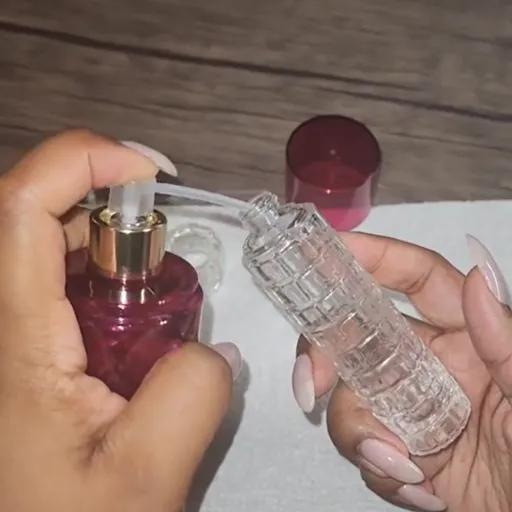
When you have chosen a clean and dry travel bottle in order to keep the scent of the perfume effectively, pick a fragrance-specific refillable bottle. Use either a funnel or pipette for accuracy to ensure a clean, uniform transfer with minimal air introduction, and only into the bottle. Be sure to fill the bottle when it is fully closed, without overfilling, to prevent leakage. Also, ensure that you tighten the cap when the bottle is complete and ready for capping. As a final step, check the sprayer to ensure correct functioning before using it. A creative approach to these precautions is a consideration for solving the problem of transferring perfume from one bottle to another efficiently and safely.
🔒 Maintaining Scent Integrity During Transfer
Fragrance transfer should preserve the scent, so there are several factors to consider:
- Ensure the Fragrance Receives Limited Air Contact: Overall exposure to air will facilitate oxidation of the fragrance, which can alter its structural integrity and shorten the scent’s lifespan. Remember to use equipment like a funnel or a pipette to help prevent exposure to vapor when transferring.
- Select the Right Container: Ensure that the bottles being filled are made of opaque glass or other non-reactive materials to prevent damage to the fragrance from light or any chemical reaction.
- Maintain Proper Hygiene: It is essential to clean the bottle and equipment used before the process to prevent contamination, which may alter the fragrance.
- No Heat or Light: Perfumes should be stored and transported in environments where there is no exposure to either light or heat, to retain their chemical equilibrium and preserve the flowers perfectly.
While such transfers and usage are taking place, these steps should be followed to maintain the state of the fragrance at the level it was initially protected.
🧼 Cleaning and Sanitizing Bottles Before Use
- Carefully rinse the bottles under warm water to remove any visible foreign particles.
- Use a gentle detergent with a fragrance that does not contain oils to wash the bottles, and then rinse the suds away.
- To sanitize, submerge the bottles and all related items in a mixture containing equal parts of rubbing alcohol (minimum 70% concentration) and water for at least 10 minutes.
- Let them dry without using towels or any other cloth on a clean surface, as this can contaminate the bottles again.
- All bottles and equipment should be used when they are dry to enhance the quality and stability of the product.
Tips for Dispensing and Storing Transferred Perfume
💧 Precision with Droppers
Always use a sterilized dropper or funnel when transferring perfume to avoid spills and ensure accurate dispensing without wastage.
🌡️ Avoid Filling to the Brim
Leave a little bit of space for air at the top of the bottle when filling as perfumes tend to expand with temperature change, and this also ensures that the spray mechanism functions perfectly.
🏠 Storage in Cool and Dark Places
A perfume is highly sensitive to light, heat, and humidity. Store your bottles away from direct sunshine or any spot where the temperature keeps fluctuating in order to retain the integrity of its fragrance.
🔒 Secure Closures
Make sure that the bottles are properly secured with caps and sprayers after use as they might get away with a little bit of evaporation and could lead to possible contamination of the perfume.
🏷️ Label Bottle Clearly
Quartz waterproofly should be used as the label for perfume bottles so that each perfume is clearly distinguished by name, brand, or even formulation date. This is especially significant for custom blends or scarce scents.
How to Transfer Different Types of Perfume
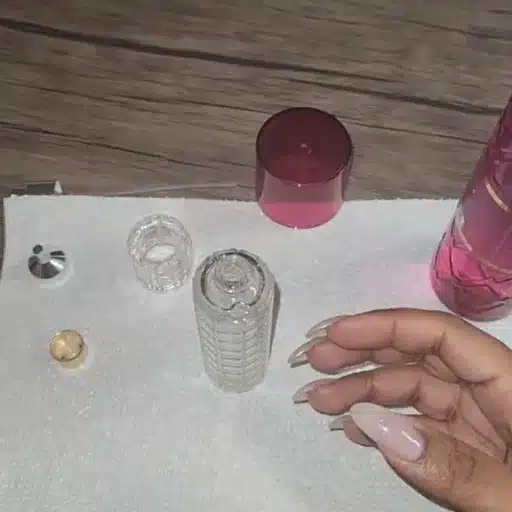
In use, the perfume is applied; depending on the perfume’s class, it is used differently. Below are the various steps for handling and transferring different types:
1. Eau de Parfum (EDP)
Use a sterilized funnel or pipette to transfer the liquid from the original bottle slowly and carefully. Never hurry the transfer into the other container to avoid spillage. Due to the high concentration of essential oils in EDP, store in an opaque bottle or one with UV protection so as to allow the perfume to keep its scent.
2. Eau de Toilette (EDT)
EDT is lighter than EDP, but precautions must still be taken. A transfer pipette should be used to prevent contamination of the liquid. Since many EDTs undergo heavier usage, ensure that the new container has a tight spray mechanism that promotes easy application and minimum evaporation.
3. Perfume Oils
Since their viscosity differs from that of alcoholic ones, special care must be given to perfume oils. Use a glass dropper for transfer accuracy. Choose roll-on or airtight bottles to avoid exposure to air, which would degrade the fragrance over time.
4. Solid Perfumes
Transferring solid perfumes entails gently melting the base with indirect heat, such as a double boiler. Pour the molten substance into another container and allow it to cool back into a solid form. The containers should be heat-resistant with tight lids.
5. Splash Bottles
When transferring a splash bottle, ensure that both the original and the new container are sterilized. Use a spout or a small funnel to channel the liquid into a new container, then seal the cap immediately to prevent evaporation.
Whatever perfume is being transferred, always exercise cleanliness so that the original scent profile remains as closely replicated as possible and, consequently, longevity is maximized. Set aside containers that best suit the storage requirements of the perfume type.
Special Considerations
⚠️ Can I Mix Different Perfumes in One Bottle?
You’re allowed to blend different perfumes into one bottle, but some thought must be given to it. Merging fragrances creates a unique scent and, in truth, can never be predicted, although it may sometimes have an unpleasant effect. Ensure that both perfumes have somewhat similar notes to avoid creating an unpleasant smell. Moreover, once mixed, the original compositions are altered forever, with the unfortunate consequence being that it won’t be easy to reproduce that particular mix. So, if you intend to layer scents for a while, mix small quantities first before working with entire bottles.
🔧 What to Do If I Encounter Errors During Transfer?
When transfers encounter errors, use the following steps for efficient resolution:
- Check the Connection: Check that all devices are correctly connected, whether by wire or via a stable wireless network. Reconnect if necessary.
- Verify Compatibility: Check if the devices and software involved in the transfer are compatible with each other. Update the software or the drivers if necessary.
- Restart the Devices: Restarting the devices can often resolve temporary glitches in both sending and receiving processes.
- Monitor Storage Space: Ensure the receiving device has sufficient space to accept the transfer. Free up space on the device if necessary.
- Retry the Transfer: Cancel the process and start over with another attempt at the transfer. The first attempt may have been interrupted.
- Consult Error Messages: These messages typically specify the nature of the problem. Let them guide further troubleshooting.
- Seek Support: If the problem persists, refer to the user manual, browse support websites, or contact customer support for more personalized assistance.
Resolving the factors systematically helps in curing most transfer errors.
Reference Sources
-
How to Put Perfume in Travel Bottle: A Step-by-Step Guide – This guide explains how to use travel bottles designed for direct filling.
-
How to Refill a Perfume Travel Bottle: 3 Easy Ways – A detailed guide on refilling travel bottles with perfume using different methods.
-
How to Transfer Perfume into Another Perfume Bottle – A practical approach using tools like syringes for transferring perfume.
-
How to Pack Perfume for Moving: A Step-by-Step Guide – While focused on packing, it includes tips on handling perfume bottles safely.
-
Any Recommended Guide for Decanting Fragrances? – A community discussion with practical advice on decanting fragrances using pipettes and other tools.
Frequently Asked Questions (FAQs)
❓ Can all types of perfumes be transferred?
Most perfumes can indeed be transferred, but with oil-based or water-sensitive formulations, utmost care should be taken to avoid altering the composition in any way.
❓ Does transferring the perfume change its quality?
Not if the transfer is made correctly. If clean containers are used and exposure to air and heat is prevented, the integrity of the perfume will be maintained.
❓ What kind of container should I use for transferring perfume?
Choose glass or CAD-quality plastic containers that are actually recommended for perfume storage, and preferably with an airtight closure to prevent evaporation.
❓ How does one clean the container prior to transfer of perfume?
Wash the container with mild soap and warm water, rinse thoroughly, and allow it to air-dry completely to prevent contamination.
❓ Can the scent change after transfer?
If the transfer is done correctly, it should not alter the scent; however, any contaminants that come into contact with the fragrance, or improper storage conditions, can indeed affect it.
❓ What are the best ways of transferring perfume from one bottle to another?
Using a syringe or a small decanter for transferring perfume is a convenient method. This way, you can transfer perfume precisely without spilling a drop. A clean and dry bottle is a must before proceeding. Remember, a steady hand is required to prevent the perfume from dripping or breaking out of the bottle.
❓ How does one transfer perfume using an atomizer?
Transferring perfume into an atomizer is probably the most common method. To refill, remove the sprayer from the original bottle. Then, align the atomizer’s hole with the opening and press down. This method works and prevents spilling.
🎯 Conclusion
Transferring perfume from one bottle to another is a skill that, when mastered, offers tremendous convenience and practicality. Whether you’re preparing for travel, preserving your favorite fragrance, or simply organizing your collection, following the proper techniques ensures that your precious scents maintain their integrity and longevity. Remember to prioritize cleanliness, use appropriate tools, and store your transferred perfumes in optimal conditions. With these guidelines, you can confidently transfer any fragrance while preserving its original quality and character.

